Constitutional Court of Korea
History
-
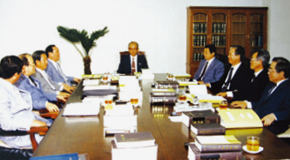
1980s
- Sep. 1988
- 1988 The Constitutional Court Act takes effect; the Constitutional Court is established.
- Sep. 1988
- 1st President Cho Kyu Kwang takes office.
- Jan. 1989
- The Court delivers its first unconstitutionality ruling, striking down the proviso of Article 6 Section 1 of the Act on Special Cases concerning Expedition, etc. of Legal Proceedings granting the state's immunity from provisional execution. (88Hun-Ka7)
-
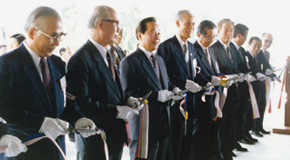
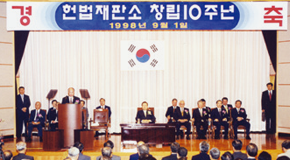
1990s
- Jun. 1993
- New Courthouse in Jae-dong completed.
- Sep. 1994
- 2nd President Kim Yong Joon takes office.
- Oct. 1996
- Pre-inspection by the Public Performance Ethics Committee provided under Article 12 of the former Motion Picture Act ruled unconstitutional.(93Hun-Ka13)
- Jul. 1997
- Prohibition of marriage between couples of the same ancestral surnames under Article 809 Section 1 of the Civil Act ruled incompatible with the Constitution. (95Hun-Ka6 etc.)
- Sep. 1998
- The Court marks its 10th anniversary and opens its website.
-
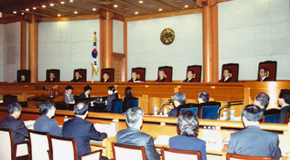
2000s
- Sep. 2000
- Electronic case-filing system launched.
- May 2004
- Petition for impeachment of former President Roh Moo Hyun rejected. (2004Hun-Na1)
- Feb. 2005
- House head system ruled incompatible with the Constitution. (2001Hun-Ka9 etc.)
- Jan. 2007
- 4th President Lee Kang Kook takes office.
- Sep. 2008
- The Court marks its 20th anniversary.
- Sep. 2008
- Hosts International Symposium commemorating the 20th anniversary.
-
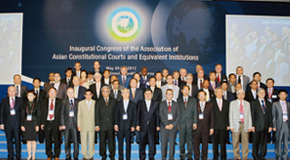
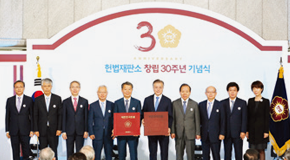
2010s
- Jan. 2011
- The Constitutional Research Institute opened.
- Aug. 2011
- Constitutional complaint against government's omission regarding the comfort women issue upheld. (2006Hun-Ma788)
- May. 2012
- Inaugural Congress of the Association of Asian Constitutional Courts and Equivalent Institutions is hosted.
- Mar. 2013
- Emergency Measures No. 1, 2, 9 were ruled unconstitutional. (2010Hun-Ba70 etc.)
- Apr. 2013
- 5th President Park Han Chul takes office.
- Sep. 2014
- Hosts 3rd Congress of the World Conference on Constitutional Justice.
- Dec. 2014
- Dissolution of a political party upheld. (2013Hun-Da1)
- Jul. 2016
- Article 2 Section 1 Subsection Ma of the Improper Solicitation and Graft Act held constitutional. (2015Hun-Ma236, etc.)
- Jan. 2017
- The AACC Secretariat for Research and Development (SRD) established.
- Mar. 2017
- Impeachment of former president Park Geun Hye upheld. (2016Hun-Na1)
- Nov. 2017
- 6th President Lee Jinsung takes office.
- Sep. 2018
- The Courts marks the 30th anniversary.
- Sep. 2018
- 7th President Yoo Namseok takes office.
-
The First Constitution
The Constitution of the First Republic
Established and proclaimed on July 17, 1948, the First Constitution stated in Chapter 5, “When the constitutionality of a law is at issue in a trial, the court shall request a decision of the Constitutional Committee, and shall rule according to the decision thereof.” It also stated, “The Constitutional Committee shall be composed of five Supreme Court Justices and five members of the National Assembly, with the Vice President as the Chairman of the Committee.” At the time, the jurisdiction of the Committee was limited to adjudication on the constitutionality of statutes. For adjudication on impeachment, there was a separate organ, the Court of Impeachment. The Constitutional Committee operated for more than ten years but its activity was not significant. It made decisions on only six cases during its operation. Among the decisions, it ruled that Agricultural Land Reform Act Article 18-1, 24-1 and the Special Measure Decree on Punishment of Crimes under National Emergency Article 9-1 were unconstitutional.
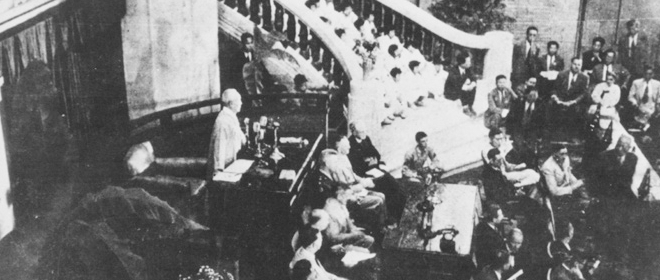
Constituent National Assembly (1948) -
1960 Constitution
The Constitution of the Second Republic
In 1960, the Constitution’s Article 8 provided for a separate Constitutional Court. Nine justices were to be appointed with terms of six years: three Justices were appointed by the President, three by the Supreme Court, and three by the National Assembly. Unlike the preceding Constitutional Committee, the Constitutional Court was to be set up as a permanent institution. The Constitutional Court’s jurisdiction included adjudication on the constitutionality of statutes, final interpretations of the Constitution, adjudication on competence disputes, adjudication on dissolution of a political party, impeachments, and litigations involving the election of the President, Chief Justice of the Supreme Court, and Justices. However, the Constitutional Court was never formed due to the 5.16 coup which took place only a month after the enactment of the Constitutional Court Act.
-
1962 Constitution
The Constitution of the Third Republic
In 1962, the Constitution entrusted adjudication on the constitutionality of statutes, adjudication on dissolution of a political party and election lawsuits to the Supreme Court. Impeachment was to be adjudicated by the Impeachment Committee, and there was no system to judge competence disputes. The Supreme Court ruled that the National Compensation Law’s provisional clause under Article 2-1, and the Court Organization Act Article 59-1 were unconstitutional. It confirmed the constitutionality of Military Criminal Law Article 47, National Compensation Law Article 3, and National Security Law Article 4-1, capital punishment in criminal law, and limiting the object of rape to women.
-
1972 & 1980 Constitution
The Yusin Constitution and Constitution of the Fifth Republic
The Yusin Constitution and the Fifth Republic Constitution set up the Constitutional Committee once again. Although it was endowed with the jurisdiction to judge constitutionality of statutes, impeachments and dissolution of a political party at the request of the courts, the power was in name only, as no judgments were made during this period.
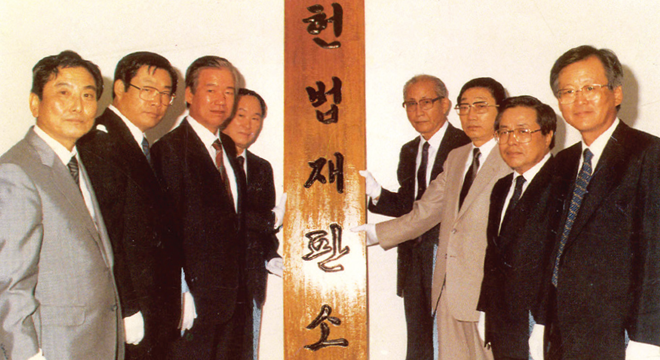
Opening of the Constitutional Court (1988) -
1988s
Foundation of the Constitutional Court
In response to the citizens’ strong aspiration for democracy and assurance of basic rights, the ruling party and the opposition party agreed to provide for the establishment of a Constitutional Court in the revised Constitution proclaimed on October 29, 1987. Finally in Chapter 6 Articles 111 through 113, it bestowed upon the Constitutional Court the adjudication on constitutionality of statutes, impeachments, dissolution of a political party, competence disputes and constitutional complaints. On August 5, 1988, as provided in Article 113-3 of the Constitution, the Constitutional Court Act was proclaimed, which outlined provisions needed for the organization and management of the Constitutional Court. On September 15, 1988, the first nine Justices were appointed, and the Constitutional Court came into being for the first time in the history of Korea.
The current Constitution ascribes all jurisdictions regarding the Constitution to the Constitutional Court. In particular, the introduction of the constitutional complaint, a system developed in European countries such as Germany that allows a citizen to petition directly to the Court on infringement of basic rights, is a symbol of the constitutional sprit that emphasizes the peoples’ basic rights, and an important event in the history of Korean constitutionalism.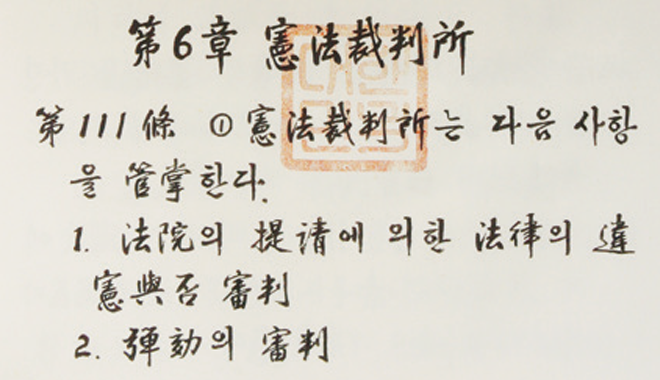
Chapter 6 of the Constitution (on the Constitutional Court)
